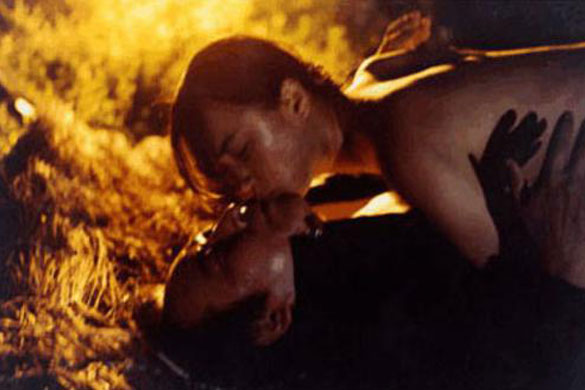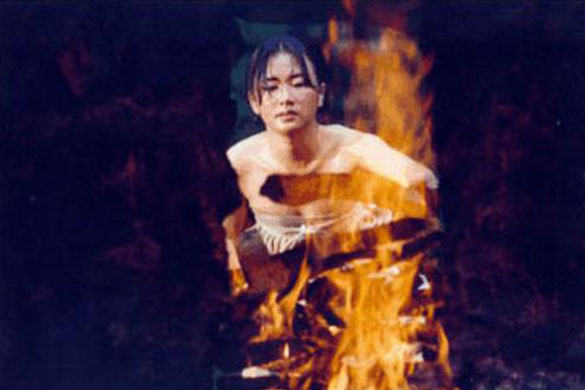"She's your wife? I was about to hit on her!..."
Synopsis:
Dori (Lee Dae-geun) lives with his elderly mother (Kim Shin-jae) in a secluded, mountainous woodland area. While he is perfectly content to spend his days felling trees, chopping and burning wood to make charcoal to sell at a local market, his mother is desperate to see her son married, often praying at a homemade shrine for a suitable woman to be ‘sent down’. So, when the old woman comes across a young girl – Soo-ni (Jeong Yun-hui) – lost and alone in the woods she immediately thinks her prayers have been answered and takes the child home telling her son that she'll be the perfect wife for him in a few years time, when she reaches a suitable age.
Years pass with Soo-ni blossoming into a beautiful young woman and, sure enough, once she reaches 18 years of age, she and the simple charcoal maker become man and wife. However, Soo-ni’s beauty is also a beacon to far more unscrupulous and self-serving individuals who will stop at nothing in their attempts to have their wicked way with her, fully prepared to utterly devastate Soo-ni and her husband's idyllic life to do so...
Review:
Those familiar with Korean films of the 60s and 70s Golden Age (and indeed earlier periods) will likely be fully aware of the tendency for cast performances to be noticeably demonstrative and specifically ‘acted'. Regardless of whether you consider that trend to be somewhat self-perpetuating (simply because that's the way things were done, one film's performances in that manner leading to another doing the same); assume finished performances were affected by the use of post-filming dialogue dubbing; think that acting was often overtly theatrical in tone because Korean cinema was still evolving and indeed learning; or all of the above, such acting histrionics serve almost as a time stamp, easily placing a film prior to both the New Korean Cinema wave of the late 90s and early 2000s and indeed the original Korean Wave of the late 80s and early 90s.
Such is the case in Does Cuckoo Cry at Night – especially in the early stages in terms of the performances of the two main male characters – but this doesn't impede or detract from the narrative in any respect and, in fact, it could even be said it (further) underlines the film's classic nature, from the very outset of proceedings.
Director Jung Jin-woo allows ample time to profile the simple, virtually idyllic life of Soo-ni and her husband and gradually introduces a number of (again classic) Korean cinema narrative tropes as possible threats to its continuation. As such, while Does Cuckoo Cry at Night is essentially a fairly straightforward story, subplot elements add an unpredictability to proceedings (as to which will ultimately become the main focus leading to the culmination of the story arc) at the same time as referencing cultural and societal themes in the midst of Korea's modernisation:
The introduction of Dori's oldest (and only) well travelled friend, for example, who is instantly and noticeably enamoured of Soo-ni’s beauty at once raises the question of whether a love triangle is set to ensue while contrasting the simple, wholly traditional life of Soo-ni and her husband with the worldly wise existence of the newcomer (traditional vs. Modern Korea, if you will). Soo-ni’s visit to a market selling modern consumer goods and her being inextricably drawn to an expensive jade ring, too, speaks of Korea's march towards modernisation and the resultant growth of societal consumerism.
 |
For the majority of Does Cuckoo Cry at Night’s running time, Soo-ni stands as almost the personification of innocence even in scenes with adult themes and indeed (largely veiled) nudity. On a number of occasions, we see Soo-ni bathing in waterfalls or swimming in natural pools and not once do such visuals seem lascivious in any respect, that is until male characters' almost drooling, peeping tom gazes add a voyeuristic lustfulness to proceedings, turning the female form from being something wholly natural and even wholesome into just an object of male sexual desire and a means to self-serving gratification... And that is where Soo-ni’s problems really begin, the beauty and innocence of the traditional being infringed upon by the grabbing selfishness of the modern, if you will.
And speaking of nudity and sexual content:
At the end of the 70s, Korean cinema was in the doldrums. Fewer and fewer Korean films were being made annually, censorship was destroying creative ventures left, right and centre and as a result cinema goers were staying away in droves, choosing to aim their media entertainment interests on television. At the same time in the wake of the Gwangju massacre, the Korean government was desperate to take the public’s focus away from politics, negate societal unrest and stem political criticism. As such, around the time of the release of 1982's Madame Aema (at the time considered to be the most explicitly erotic Korean film ever made) the government instigated what has become known as the ‘Three S' policy (Sport, Screen and Sex), the idea being that you give people what they really want on screen and they'll come back to cinema with their minds taken off sometimes controvertial political issues in the process.
Unsurprisingly, there then followed an absolute slew of Korean films featuring increasingly graphic sexual content to the extent that the 80s became known as Korean cinema’s erotic decade.
In discussions of eroticism and adult content in Korean cinema, Does Cuckoo Cry at Night is often lumped in alongside such fare but it was, in actuality, earlier and prior to the ‘Three S' policy and in spite of the KOFA YouTube channel earning that it is suitable for adults only, it is far tamer in its depictions of sex and nudity than many of the movies that followed it. That's certainly not a criticism on my part and in fact the often veiled nature of such content (Soo-ni’s modesty often covered by foliage, rocks, fire or only seen underwater) actually adds to the narrative itself, and a lustful character’s desperation to see her wholly unveiled becomes all the more believable as a result, regardless of how out of line his lecherous, salacious demands are.
 |
As a final note: The inclusion of references to a cuckoo throughout Does Cuckoo Cry at Night are frankly inspired. When we first meet 12-year-old Soo-ni lost in the woods, we learn that she was separated from and left behind by her mother while she was chasing after a cuckoo. Her obsession with the bird comes from her memory of watching her mother – a traditional Korean dancer – sneaking out at night to (from Soo-ni’s perspective) listen to nearby cuckoos at night. However, Soo-ni’s mother was in fact sneaking out to give sexual favours to various men (a mirroring of and yet another reference to the aforementioned themes) – a fact that, when Soo-ni finally realises it as an adult, shapes the pivotal decision she makes, the ultimate action she takes, that forms the culmination of the entire narrative.
 |
Summary:
Does Cuckoo Cry at Night tells the story of the simple, traditional life of a charcoal maker and his innocent wife, subplot elements and characters threatening their idyllic existence standing as metaphors to the modernisation of Korea itself.
DOES CUCKOO CRY AT NIGHT (뻐꾸기도밤에우는가) / 1980 / Directed by Jung Jin-woo
|





